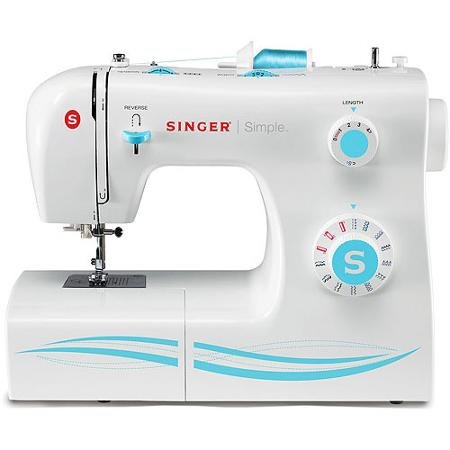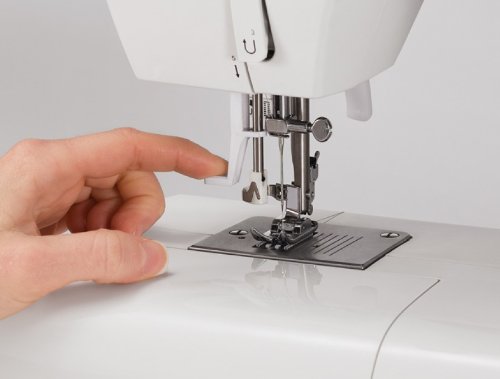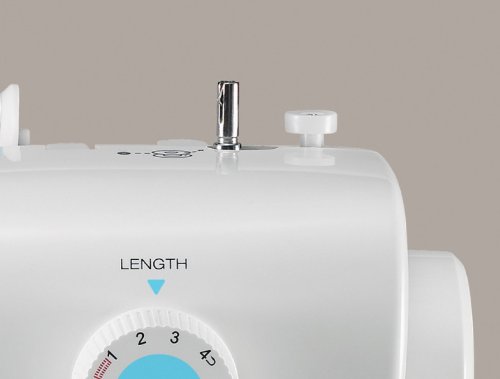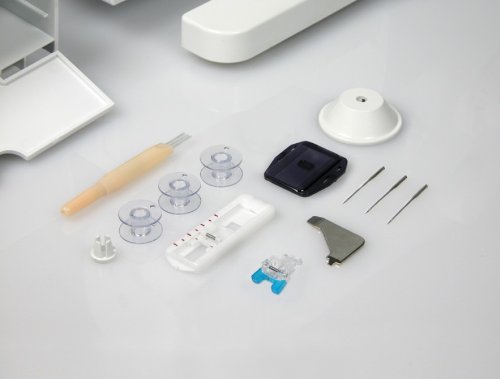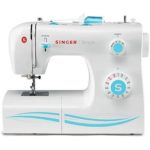Welcome to my Singer 2263 Review. This sewing machine reminds me that nothing with a front-loading bobbin should ever be allowed to use the word “simple” in its name.
If you read the post I wrote about my run in with my mom’s old Viking machine, you’ll know that front-loading bobbins and I are not friends. They’re not impossible to use, they’re just not easy.
In fact, most people really like this machine except for one, repetitive issue – problems with the bobbin thread. Somehow, I’m not surprised.
It’s too bad, really, because I adore the blue accents on this one. They just make the machine look pretty trendy. I could see it sitting happily in a sunny yellow craft room or in a girl’s bedroom of purple, pale green, and sky blue. The stitch selection is pretty nice, too, and the fully electronic functionality is appealing to those who don’t want a computerized sewing machine.
Singer 2263 Review: Types of Stitches
There are a total of 23 built-in sewing stitches including a four-step buttonhole. Most sewing machines that do buttonholes have one of two types – a 4 step, like this one, or a 1-step buttonhole. The difference is really just a matter of convenience.
A sewing machine with a four-step buttonhole style requires more manual intervention to complete. It breaks the buttonhole down into four parts – two, long parallel lines of thread for the sides of the buttonhole and two shorter, parallel lines of thread for the ends. To do a four-step buttonhole you select the stitch for one side, sew it, select the stitch for an end, sew it, select the stitch for the other side, sew it, and then select the stitch for the final end and sew it.
You don’t have to move the fabric around, you just have to control the length of the stitches and tell the sewing machine which part of the buttonhole you’re working on next. For a one-step buttonhole, you would just set the length and width settings in advance rather than having you turn the dial or push the button to move from one length of stitches to the next. The nice thing about a four-step buttonhole is that you can easily make buttonholes just about any size you want.
Stitch width is adjustable to 5mm and stitches length can be adjusted to 4mm using two dials located at the top right of the machine. Not all stitches can be adjusted, which is normal, but the straight and zigzag stitches are adjustable and those are the ones most often modified.
There’s a good selection of overedge stitches for making sturdy seams and stretch stitches for working with different types of fabrics. Using the right needle, the machine will sew through a couple of layers of denim and canvas but probably not much more than just a couple of layers without difficulty.
Singer 2263 Review: Presser Feet
The Singer 2263 sewing machine comes with 3 snap-on presser feet. Additional presser feet like a quilting foot, blind hem foot, and satin foot can be purchased separately.
The presser foot pressure is not adjustable but the height settings include the standard up, down and extra high up so you can put thick layers or quilting under the presser foot. The lever to move the presser foot up and down is situated behind the needle arm.
- General Purpose
- Buttonhole Foot
- Button Sewing Foot
Singer 2263 Review: Features and Functionality
A number of advances have been made in sewing machines in recent years and most of those are meant to do two things – make sewing easier and keep the thread from jamming or breaking while sewing.
While the Singer 2263 is a mechanical machine, it includes a few of those advancements like an automatic needle threader and horizontal thread delivery but then, for whatever reason, they used a front-loading bobbin system. If you learned to sew on an old sewing machine, you might be an old hand at that kind of bobbin but it is incredibly frustrating for beginners to learn. One, tiny flaw in loading the bobbin, threading the bobbin or inserting the bobbin and you’re likely to spend more time fixing thread jams than actual sewing.
There are a couple of advantages to a front loading bobbin which makes it worthwhile for sewing machine manufacturers to continue to produce. If you sew projects that require you to switch thread types or to change thread colors mid-stream in a line of stitches, you can’t do that on a top loading bobbin without removing your project because the bobbin case is right under the needle plate. However, you can reach the bobbin for replacement without lifting your fabric on a front-loading bobbin. For most general types of sewing, however, a top loading bobbin works perfectly and is so much easier to use!
The full list of features:
- Automatic needle threader
- Automatic bobbin winding
- Horizontal thread delivery
- Free arm sewing – just remove the extension arm
- Adjustable top thread tension
- Adjustable bobbin thread tension
- Built-in manual thread cutter on the side
- Reverse sewing lever
- Takes size 9-18 needles (the higher the needle size, the thicker the fabric it can handle)
- Hole for a 2nd spool pin located on top of over-sized thread spools
- Light over the workspace
- Built-in carry handle
The sewing machine body is made of hard, plastic resin over a heavy duty metal frame. It only needs to be oiled once a year and this can be done by the service tech if you take it into a Singer service center for an annual checkup.

